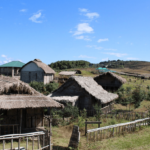Kongthong Village : In Meghalaya, there’s a unique village where individuals have a melody instead of a traditional name. This intriguing fact was shared by our guide during our first visit to Cherrapunjee in 2012. I was eager to explore this village on that trip, but I was informed that reaching Kongthong, known as the Whistling Village, required a challenging 8-10 km trek. Unfortunately, our itinerary didn’t allow time for this detour, so I reluctantly postponed the visit, but I vowed to return someday.
On our subsequent trip to Meghalaya, I still didn’t make it to Kongthong. However, after seven years of traveling, multiple visits to Meghalaya, and the creation of a travel blog (which we started in 2014), we finally included Kongthong in our itinerary. Fortunately, the trek was no longer necessary, as a motorable road had been built, albeit a rough one. We were finally able to visit Kongthong, stay with the locals, and experience the extraordinary culture and natural beauty of this Khasi village. In this account, we share our experience of staying in Kongthong, interacting with the local community, and hearing the enchanting whistles and tunes used for communication.
Kongthong, the Whistling Village in Meghalaya
Located about 60 km from Shillong, nestled in the heart of unspoiled nature, lies Kongthong, Meghalaya’s Whistling Village. Like many other villages in the East Khasi Hills, Kongthong is serene and picturesque. This small hamlet, situated in the Khat-ar Shnong region, has around 700 residents who primarily rely on agriculture and livestock farming. The village, perched on a cliff edge, is dotted with charming huts surrounded by gardens and betel trees, offering breathtaking views of the surrounding landscape.
Kongthong is not just another beautiful and offbeat village in Meghalaya. What makes Kongthong truly unique is its people’s distinctive way of identifying each other. Along with their given names, each resident also has a personalized lullaby or whistle. This tune, which is entirely unique to the individual, serves as a second name of sorts. Unlike our names, no two individuals share the same lullaby. Isn’t that fascinating?
In Kongthong, when a child is expected, the mother begins creating a special melody for the baby. Once the child is born, the mother sings this tune to the infant, and it becomes their lifelong identity. This lullaby, a wordless melody, is recognized and remembered by the villagers. The mother, along with other adults, continuously hums this tune so that the child associates with it. Known as ‘jingrwai lawbei’ in the local language, these tunes are often inspired by the sounds of nature, particularly birds.
The melody, which can last from 30 seconds to a minute, becomes a way for mothers to call their children, who respond instantly. In the hilly terrain, where sound travels far, this method of communication is particularly effective, even over long distances.
The Hills Surrounding Kongthong
This age-old tradition has been passed down through generations, and no one in the village can pinpoint when it began. However, there are a few legends associated with it. According to local folklore, evil spirits from nearby forests could harm someone if they heard their name, so villagers developed this method of calling each other using tunes instead of names. Of course, these are just stories, but they add to the mystique of Kongthong.
Our 2-Day Stay in Kongthong – A Unique Experience
Our journey to Kongthong began in Shillong. We discovered that there is only one shared jeep from the Shillong Bara Bazar Sumo Stand to Kongthong, which departs in the afternoon. We booked two seats the day before and, right on schedule, the jeep left Shillong, carrying us toward Kongthong. The roads were clear, traffic was minimal, and the air was crisp and fresh. After passing through Mylliem, we reached Mawjrong, a small town where the jeep paused to drop off goods like vegetables, chicken, and eggs. In these remote areas, the jeeps serve as both passenger and cargo transport.
Shared Jeep from Shillong to Kongthong
From Mawjrong, the road splits: one path leads to Sohra, while the other heads down the Khat-ar Shnong Road towards Kongthong, which is another 26 km away. It was late in the afternoon when we began the hilly drive towards Kongthong. Meghalaya’s roads are generally in good condition and often run through plains, but this route was different. Here, for the first time in Meghalaya, we encountered treacherous roads with a cliff on one side and a deep gorge on the other. As we continued, clouds descended unexpectedly, adding to the dramatic scenery.
Bumpy and Broken Roads to Kongthong, Meghalaya
We witnessed something truly spectacular as the golden hour approached. The sunlight bathed the cliffs in a beautiful glow, and the sky took on an extraordinary hue. Although we couldn’t stop the jeep to take photos, the view was one to be savored with the eyes, a moment too pure to capture on camera.
Eventually, we reached a point where the road ended. In the past, this was the spot where people began their trek to Kongthong. Although a road has been partially constructed, it remains incomplete. After a brief rest, we continued our journey on the rough terrain towards Kongthong. It was already dark, and we still had 10 km to go. Suddenly, our jeep stopped due to a landslide and a broken water pipe, which had closed off the road ahead.
The Way to Kongthong – Where the Trek Used to Begin
In such situations, there is little to do but wait. And wait we did. A large yellow JCB was busy clearing the debris while workers repaired the water pipe. We waited for nearly two hours. Agni, bored, took out his camera and practiced night photography, while I found solace in my Kindle. Finally, with the road cleared, we resumed our journey to Kongthong. By the time we arrived, it was dark, and the village was already asleep.
Night Sky in Kongthong
We contacted our host, Rothell, to inform him of our late arrival. We had reserved a room at Travellers’ Nest, located at the edge of the village. By the time we reached, it was 8:00 pm, quite late by Kongthong’s standards. Exhausted, we quickly settled into our room, had dinner, and called it a night.
The next morning, we awoke early, eager to explore Kongthong. The first place we explored was Travellers’ Nest itself, a beautiful area surrounded by gardens. The accommodation consists of two huts, each capable of housing six people. As the only guests, we had an entire hut to ourselves. The kitchen and dining area are separate, offering a stunning view of the mountains from the dining room veranda. We enjoyed breakfast and lunch there, dining with a view.
Inside the Hut at Travellers’ Nest
Our guide, the caretaker of Travellers’ Nest, led us on a tour of the village. Kongthong is a place of serene beauty. One of our stops was the home of Babu Derma, one of the oldest men in the village. He possesses a deep knowledge of the area’s traditions but is a humble man. When we arrived, he was preparing to head out to his field. Though busy, he took time to share his insights on Kongthong and the tradition of ‘jingrwai lawbei’ before resuming his work.
The Khasi People and Their Unique Names
There are a few waterfalls near Kongthong, but visiting them requires a full day of trekking, so instead, our guide, Feeding Star, invited us to his home. Yes, Feeding Star is his real name. Christian Khasis often have such unusual names. Traditionally, the Khasis practiced animism, worshipping nature and natural objects like trees and stones. However, with the arrival of Christian missionaries, many converted to Christianity, adopting English names. Though they may not fully understand the meanings of these names, they often choose them for their English sound. We met Feeding Star and Easter in Kongthong, Bright Star in Shnongpdeng, and Friday Lyngdoh in another remote village.
While the villagers of Kongthong do have conventional names, they rarely use them. Instead, they call each other using their personalized tunes. As we wandered through the village, we frequently heard whistling sounds, which at first we mistook for bird calls. However, Feeding Star explained that these sounds were actually ‘jingrwai lawbei,’ villagers communicating with one another. On our way to his house, we also met Easter, a schoolteacher at Kongthong Primary School.
The Hindi Teacher in Kongthong
Easter has an interesting job as a Hindi teacher, teaching not only the children but also the elderly villagers. During the day, he teaches Hindi to school students, and in the evening, he helps the local community learn the language. As tourism grows in the village, knowing basic Hindi is becoming increasingly important. Many young villagers are now traveling to places like Delhi for higher education, and learning Hindi is an essential skill for them. The villagers even built a small wooden hut for Easter to live in. Easter is a friendly and approachable person, and we quickly formed a connection with him.
Inside a Khasi Home
Star’s home, where his wife welcomed us with a warm smile. We were then served a traditional Khasi meal in the kitchen. Khasi houses typically have a separate kitchen with a fireplace, which also serves as a heater during the winter. In the kitchen, we were served rice, dal, fish, dry fish chutney, wild herb chutney, and local eggs. The ingredients used in Khasi cooking are typically sourced from home gardens. After the delicious meal, we were treated to local pork and rum, a common beverage in these chilly, high-altitude regions.
Khasi Food at a Local Home
In Feeding Star’s home, the most noticeable item was the huge brass cooking pot or ‘Khiew Ranei,’ an heirloom passed down through generations. Typically, Khasi homes have minimal furniture, as Khasis prefer sitting on the floor, a habit shared by many indigenous people in Northeast India. We stayed for about an hour and shared a drink with them. As night approached, it was time to head back to our hut. That evening, Feeding Star and Easter came by and invited us to join a community gathering. We spent the night drinking more rum, eating traditional snacks, and listening to traditional Khasi songs. The night in Kongthong was as magical as it could get.


